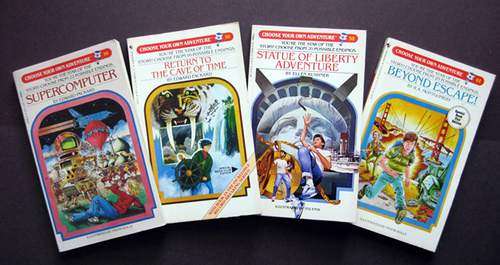
In my previous article, I explored the immediate answer to our brand marketing woes: interactive content. But if history is any indicator, we can be confident that today’s innovations will quickly evolve into something we’ve only just begun to imagine.
In this last article on brand marketing evolution, we’re going to pull back the veil between the present and future to explore how brand content may change over the next few years. I have 4 hunches to share with you, but I’d also love to hear what you think is in store.
True Multi-Device Distribution
Many brands (not naming any names) have been slow to adapt their content strategy to account for mobile devices. As we’re now starting to add smartwatches, other wearable technology, and huge digital displays to the mix, brands will no longer be able to get away with creating content that only works on desktop.
The idea of one-and-done content creation will fade away in the harsh reality of pixels and proclivities. The content you produce for PCs is not going to translate for a teeny smartwatch screen, and neither will your wearable device content translate for massive displays. Consumers also won’t want to use their smartwatch in the same way they use their other mobile devices or computer.
Brands will need to start thinking about how to best leverage the native functionality and usage patterns of each device—and some have already started. Early smartwatch app creators have dialed back their content to be bite-sized and timely (pun intended). Domino’s smartwatch order tracker is a great example:

(Source: Domino’s)
Brands who are crushing it on mobile are leveraging location data and action-oriented behaviors to drive more in-person visits to physical storefronts where their products are sold. Additionally, big brands like Travelers are investing in high-touch, large-screen content like this interactive ad they ran in the Hartford Airport:
Personalization: Choose Your Own Adventure
Brand marketers have taken the first step toward personalizing their content and communications for individuals. CRM software now allows us to incorporate names and other account data into emails and web pages. But this level of personalization is only the beginning. As we’re able to capture more information about our audiences, we’ll be able to start serving up rich content that’s tailored to an individual’s demographics, preferences, or interactions with our brands.
In tandem with this big data approach to personalization, marketers are also going to start creating more non-linear content that gives their viewers additional control and flexibility over the story. Remember those Choose Your Own Adventure books from the early 90s? People loved those for a reason—they were able to actively shape where the story went depending on their choices. Interactive content can utilize the same principle, but in a much more elaborate way.
(Source: Lucid Books)
Augmented Reality (AR): Where Physical and Virtual Worlds Collide
Augmented Reality, or AR, has been talked about a lot in the education and gaming communities, but it’s only now starting to enter into the world of brand marketing. In case you’re not familiar with AR, it’s essentially any technology that overlays digital information on top of the physical world using 3D mapping technology. This additional information can take the form of experiences, products, characters, or even entire worlds that appear as your surroundings. You need special glasses or a second screen (smartphone or tablet) to view these digital overlays.
Brands are just now beginning to use AR for advertising purposes. Check out this cool Tic Tac ad at a NYC bus stop:
Other companies are using AR in conjunction with print advertising. Qualcomm’s Vuforia division created an ad experience for a Dutch shoe company that uses a print ad to trigger 3D shoe overlays you can swipe through on your mobile device:
The big boys of software development, Google and Microsoft, are investing heavily in AR, which is causing brands to start to pay attention more closely. Microsoft started to advertise its HoloLens product suite to the masses earlier this year, even though it’s not due out until 2016; Google, after the lukewarm adoption of Google Glass, has thrown its full weight behind its AR Project Tango.
What AR will become and how brands will leverage this technology remains to be seen, but any content creator who’s been yearning to bring their stories to life will be eager to hop on this bandwagon.
Face to Face Content: Guerrilla Marketing Goes Mainstream
In spite of all our technological advances, we still haven’t found a more engaging medium than connecting with people in person. As technology continues to proliferate, there will be an even greater need for people to unplug and spend time hanging out in the real world. The face-to-face “guerrilla” marketing tactics that brands have been employing will eventually become mainstream engagement tactics. Campaigns that delight and benefit consumers (think the Lays human claw stunt and McDonald’s ice coupon vending machines) will continue to win big points for brands.

(Source: Creative Guerrilla Marketing)
There will also be a concerted effort from brands to host events that help customers and fans connect in real life. Red Bull has already mastered the art of in-person events that have nothing to do with their product. In bringing together like-minded people and sponsoring really cool stuff, they drive more sales and customer loyalty without making their drinks the star of the show.
Evolution: Givens and Variables
We’ve spent the past two weeks looking back at the history of brand marketing as it’s progressed from print to digital to interactive content. Today, we focused on looking at where brand content may be headed in the future. The final question we’re left with is: Does brand marketing evolution mean that we have to constantly re-learn how to be brand marketers every time technology changes? Or are there givens we can fall back on no matter what medium we use to reach our audiences?
The short answer is that people are still people. They have the same basic needs, problems, and desires that all people have had throughout the course of history. While the way brands position their products or solutions will change to accommodate new social trends and new modes of communication, what we communicate will remain fundamentally the same. Telling stories about our brands in a unique and compelling way is still the end game, whether we tell those stories with print articles, TV ads, emails, or a smartwatch apps.
The goal we’ve been tasked with as brand marketers isn’t to learn how to use cool new technology. The goal is to connect with our prospects and customers in a meaningful way that makes them want to do business with us. Technology is just one means to a much greater end.
View the original blog on Ceros.com.
(228)









